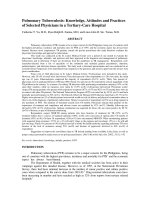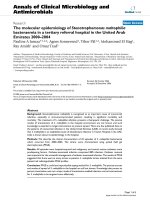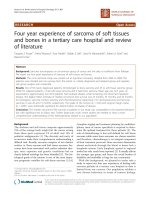Study of inducible Clindamycin resistance in Staphylococcus Aureus in a Tertiary care Hospital
Bạn đang xem bản rút gọn của tài liệu. Xem và tải ngay bản đầy đủ của tài liệu tại đây (302.9 KB, 8 trang )
Int.J.Curr.Microbiol.App.Sci (2019) 8(3): 1471-1478
International Journal of Current Microbiology and Applied Sciences
ISSN: 2319-7706 Volume 8 Number 03 (2019)
Journal homepage:
Original Research Article
/>
Study of Inducible Clindamycin Resistance in Staphylococcus aureus
in a Tertiary Care Hospital
Javeria Firdous1* and Basawaraj S. Patil2
1
Department of Microbiology, KBN Institute of Medical Sciences, Kalaburagi, India
2
Department of Microbiology, M.R Medical College, Kalaburagi, India
*Corresponding author
ABSTRACT
Keywords
Methicillin
Resistant
Staphylococcus
aureus (MRSA),
Methicillin
Sensitive
Staphylococcus
aureus (MSSA),
Inducible
clindamycin
resistance, Double
disc diffusion
method (D test)
Article Info
Accepted:
12 January 2019
Available Online:
10 February 2019
Very few therapeutic options are available from the time of emergence of MRSA.
Macrolide lincosamide streptogramin B (MSLB) antibiotics can be used in such scenarios
with clindamycin being the preferred agent due to its excellent pharmacokinetic properties.
Staphylococcal resistance to clindamycin may be inducible (iMLSB - inducible MacrolideLincosamide Streptogramin B resistance) or constitutive. The treatment of patients
harbouring iMLSB Staphylococci with clindamycin leads to the development of
constitutive resistance, subsequently leading to therapeutic failure. If inducible
Clindamycin resistance can be reliably detected by placing relevant disc adjacent to each
other at proper distance as a routine basis in clinically significant isolates, Clindamycin
can be safely and effectively used in patients with true Clindamycin susceptible strains.
Objective of the study is to determine prevalence of inducible clindamycin resistance in
S.aureus. 100 Staphylococcus aureus isolates collected from various clinical samples were
subjected to routine antibiotic susceptibility testing and screening for Methicillin
Resistance was done as per CLSI guidelines. Detection of inducible clindamycin resistance
was done using Double disk diffusion test or D test. Out of 100 S. aureus (88 MRSA, 12
MSSA) isolates, prevalence of inducible clindamycin resistance was found to be 39% (39
isolates). Inducible Clindamycin resistance was found to be higher in MRSA 40.9% (36
MRSA isolates) as compared to MSSA 25% (3 MSSA isolates). We conclude that
whenever clindamycin is intended for S. aureus infection, the microbiology lab should
tests the isolated organism for iMLSB by D test.
Introduction
In genus Staphylococci, the most virulent
species is Staphylococcus aureus1. Methicillin
resistance to S. aureus was first reported in
1961. At present MRSA is a major
nosocomial pathogen worldwide2. Very few
therapeutic options are available from the
time of emergence of MRSA. Macrolide
lincosamide
streptogramin
B
MSLB
antibiotics can be used in such scenarios3 with
clindamycin being the preferred agent due to
its excellent pharmacokinetic properties4.
Clindamycin can be given orally or
parenterally. Food doesn’t interfere with its
absorption. It has wide distribution in
inflamed tissues except for the CNS as it does
not cross the blood-brain barrier even in the
1471
Int.J.Curr.Microbiol.App.Sci (2019) 8(3): 1471-1478
presence of inflamed meninges. Dosage
adjustments will not be required even in
severe hepatic or renal dysfunctions5.
Three unrelated groups of antimicrobial
agents share the same ribosomal binding site
in
the
bacterial
cellmacrolides
(erythromycin), lincosamides (clindamycin),
and type b streptogramins (MLSB). Therefore,
it is possible that resistance to one group of
antibiotics (macrolides) might predict
resistance to the other groups. Resistance to
erythromycin is used as an indicator of
possible
resistance
to
clindamycin6.
Staphylococcus
aureus
resistance
to
macrolide can be mediated by
A) msrA gene coding for efflux mechanism
B) erm gene encoding for enzymes that
confer inducible or constitutive resistance
to MLSB antibiotics.
The most mechanism for acquiring resistance
is through erm gene. In constitutive resistance
erm gene will always produce r-RNA
methylase. It provides resistance to both
erythromycin and clindamycin in vivo as well
as in vitro. It can be easily identified by using
routine disk diffusion test. In inducible
resistance r-RNA methylase is produced only
in the presence of an inducing agent8. In such
cases inducible resistance to clindamycin are
difficult to detect in vitro by using routine
laboratory as they appear resistant to
erythromycin and sensitive to clindamycin.
The treatment of patients harbouring iMLSB
Staphylococci with clindamycin leads to the
development of constitutive resistance,
subsequently leading to therapeutic failure9.
Erythromycin is an effective inducer whereas
clindamycin is a weak inducer. If inducible
Clindamycin resistance in S. aureus can be
reliably detected by D-test on a routine basis,
Clindamycin can be safely and effectively
used in patients with true Clindamycin
susceptible strains10. The laboratories and
clinicians must be aware of local prevalence
of iMLSB. From hospital to hospital
prevalence
of
inducible
clindamycin
resistance may vary11. The present study is
therefore undertaken to know the prevalence
of inducible clindamycin resistance in our
hospital as well as aware and aid our
clinicians in using appropriate antibiotics to
treat the infections of patients caused by
Staphylococcus aureus in Khaja Banda
Nawaz Teaching & General Hospital,
Kalaburagi.
The main objectives of this study includes to
determine the prevalence of inducible
clindamycin resistance in Staphylococcus
aureus
Materials and Methods
This study was conducted at Microbiology
laboratory of Khaja Banda Nawaz Teaching
and General Hospital, attached to KBN
institute of Medical Sciences, Kalaburagi for
a period of one year i.e., from January 2018 to
December 2018. Observational Cross
Sectional Study was performed. Written
informed consent was taken from the subject
after explaining the nature of the study. This
study was approved by ethical committee.
A total of 100 isolates of S. aureus were
collected from various clinical specimens.
Identification of Staphylococcus aureus was
done as per standard guidelines12. Each isolate
was subjected to the disk diffusion test for
detection of MRSA as recommended by the
CLSI 10.
Detection
of
10
resistance
inducible
clindamycin
The isolates which were resistant to
erythromycin were further studied for
inducible clindamycin resistance by doing D
1472
Int.J.Curr.Microbiol.App.Sci (2019) 8(3): 1471-1478
test. Lawn culture of S. aureus isolates was
prepared on Mueller-Hinton agar plate and
standard discs of erythromycin (15 μg) and
clindamycin (2 μg) were placed 15-26mm
apart and incubated at 370 C for 18-24 hours.
Four different phenotypes were detected in Dtest which are as follows:
1. D test positive or Inducible MLSB
phenotype: S. aureus isolates which were
sensitive to clindamycin (zone size ≥21
mm) and resistant to erythromycin (zone
size ≤13 mm) and giving D shaped zone
of inhibition around clindamycin disc
with flattening towards erythromycin
disc were taken as D test positive (Figure
1).
2. D test negative or MS Phenotype: S.
aureus isolates which are sensitive to
clindamycin (zone size ≥21 mm) and
resistant to erythromycin (zone size ≤13
mm) and giving circular zone of
inhibition around clindamycin disc were
taken as D test negative (Figure 2).
3. Constitutive MLSB phenotype: S. aureus
isolates which showed resistance to both
clindamycin (zone size ≤14 mm) and
erythromycin (zone size ≤13 mm)
(Figure 3).
4. S. aureus isolates which were sensitive to
both erythromycin (zone size ≥23 mm)
and clindamycin (zone size ≥21 mm).
(Figure 4).
Results and Discussion
Cefoxitin disc sensitivity done on MuellerHinton agar revealed that 88 isolates were
Methicillin Resistant Staphylococcus aureus
(MRSA) and 12 were Methicillin Sensitive
Staphylococcus aureus (MSSA) (Table 1).
Out of the 100 S. aureus (88 MRSA; 12
MSSA) isolates, 30 (24 MRSA; 6 MSSA)
isolates were susceptible to both erythromycin
and clindamycin, 27 (24 MRSA; 3 MSSA)
isolates showed constitutive MLSB resistance
i.e., resistant to both erythromycin and
clindamycin, 39 (36 MRSA; 3 MSSA)
isolates showed inducible clindamycin
resistance i.e., resistant to erythromycin and
sensitive to clindamycin and showing D test
positive and 4 (all from MRSA) isolates
showed MS phenotype i.e., resistant to
erythromycin and sensitive to clindamycin
and showing D test negative (Table 2).
Table.1 Distribution of S. aureus based on Methicillin Sensitivity
Methicillin Sensitivity
MRSA
MSSA
Total
Frequency
88
12
100
Table.2 Erythromycin & Clindamycin susceptibility pattern of S. aureus isolates
Susceptibility pattern
E-S, CD-S
E-R, CD-R (Constitutive MLSB)
E-R, CD-S; D test positive (Inducible MLSB)
E-R, CD-S; D test negative (MS Phenotype)
Total
1473
MRSA
24
24
36
04
88
MSSA
06
03
03
0
12
Total
30
27
39
04
100
Int.J.Curr.Microbiol.App.Sci (2019) 8(3): 1471-1478
Table.3 Erythromycin and Clindamycin susceptibility pattern of MRSA isolates
Susceptibility pattern
E-S, CD-S
E-R, CD-R (Constitutive MLSB)
E-R, CD-S; D test positive (Inducible MLSB)
E-R, CD-S; D test negative (MS Phenotype)
Total
MRSA
24 (27.3%)
24 (27.3%)
36 (40.9%)
04 (4.5%)
88(100%)
Table.4 Various studies across India reporting the prevalence of Inducible Clindamycin
Resistance in S. aureus
Sl. No
Study Series
1.
2.
3.
4.
5.
6.
7.
8.
9.
10.
11.
12.
Ciraj et al.,17
Gadepalli et al.,18
Shantala et al.,7
Saikia et al.,19
Deepak juyal et al.,20
Dhanalakshmi et al.,21
Amruth KU et al.,6
Ajantha et al.,22
Lall et al.,23
Schreckenberger et al.,.24
Levin et al.,25
Present study
Inducible Clindamycin Resistance
MRSA(%)
MSSA(%)
38.4
12.9
30
10
32.5
15.53
9.3
3.3
13.3
28.9
13.1
6
35.33
11.74
74
45
37.1
6
7
20
12.5
68.5
40.9
25
Figure.1 D-test Positive (E-R, CD-S; Inducible MLSB)
1474
Int.J.Curr.Microbiol.App.Sci (2019) 8(3): 1471-1478
Figure.2 D-test Negative (E-R, CD-S; MS Phenotype)
Figure.3 Constitutive MLSB (E-R, CD-R)
Figure.4 S. aureus sensitive to both Erythromycin and Clindamycin
(E-S, CD-S)
1475
Int.J.Curr.Microbiol.App.Sci (2019) 8(3): 1471-1478
Out of the 88 MRSA isolates, 24(27.3%) were
susceptible to both erythromycin and
clindamycin, 24 (27.3%) showed constitutive
MLSB resistance, 36% (40.9%) showed
inducible clindamycin resistance and 4 (4.5%)
showed MS phenotype (Table 3).
Our study revealed the prevalence of MRSA
at Khaja Banda Nawaz Teaching and General
Hospital to be 88% which is slightly higher
than the findings observed by other workers
like by Frazee et al.,13 and Khanal et al.,14
who reported 75% and 68% MRSA isolates
respectively. This may be due to the
indiscriminate and empirical use of
antibacterial agents in our hospital. Our study
findings are in contrast to findings observed
by Kiran K Mokta et al.,15 and Jyoti kumari et
al.,16 who reported only 23.42% and 30.2 %
MRSA isolates respectively.
Various workers have reported prevalence of
Inducible Clindamycin Resistance among
MRSA isolates varying from 9.3% to 74%
and among MSSA isolates varying from 6%
to 45% as shown in Table 4.
74% inducible clindamycin resistance in
MRSA isolates.
Our study also observed that percentage of
inducible clindamycin resistance was higher
amongst MRSA (40.9%) as compared to
MSSA (25%). Yilmaz et al.,5 (24.4% in
MRSA and 14.8% in MSSA), Gadepalli et
al.,18 (30% in MRSA and 10% in MSSA) and
Mohammed Rahbar et al.,26 (22.6% in MRSA
and 4% in MSSA) reported higher percentage
of inducible clindamycin resistance in MRSA
as compared to MSSA. However our findings
are in contrast with Schreckenberger et al.,24
(7% in MRSA and 20% in MSSA) and Levin
et al.,25 (12.5% MRSA and 68% MSSA) who
reported higher percentage of inducible
clindamycin resistance in MSSA as compared
to MRSA.
Our study observed constitutive resistance of
27.3% in MRSA isolates, however Angel et
al.,27 did not reported any of the strains.
Our study observed that out of 88 MRSA
isolates, 36(40.9%) showed inducible
clindamycin resistance and out of 12 MSSA
isolates,
3(25%)
showed
inducible
clindamycin resistance. In MRSA isolates
both constitutive and inducible resistance
phenotypes were found to be higher compared
to MSSA.
Our study observed that out of 100 S. aureus
(88 MRSA; 12 MSSA) isolates, 30
{24(27.3%) MRSA; 6(50%) MSSA} were
susceptible to both erythromycin and
clindamycin, 27 {24 (27.3%) MRSA; 3(25%)
MSSA} isolates showed constitutive MLSB
resistance, 39 {36 (40.9%) MRSA; 3(25%)
MSSA}
isolates
showed
inducible
clindamycin resistance and 4 {4(4.5%)
MRSA; 0(0%) MSSA} isolates showed MS
phenotype.
Our study observed inducible clindamycin
resistance of 40.9% in MRSA. Ciraj et al., 17
reported 38.4%, Amruth et al.,6 reported
35.33% and Lall et al.,23 reported 37.1%
inducible clindamycin resistance in MRSA
isolates. However our findings are in contrast
with other studies conducted by Saikia et
al.,19 reported only 9.3% MRSA isolates with
inducible clindamycin resistance and Ajantha
et al.,22 who reported a high prevalence of
This observation suggest that checking for
inducible clindamycin resistance is important,
otherwise clindamycin therapy therapy would
have been started due to misidentification of
erythromycin resistant S. aureus isolates as
clindamycin sensitive, ultimately leading to
therapeutic failure. On the other hand,
Clindamycin therapy is good therapeutic
option in light of the restricted range of
antibiotics available in those erythromycin
1476
Int.J.Curr.Microbiol.App.Sci (2019) 8(3): 1471-1478
resistant S. aureus isolates showing negative
result for inducible clindamycin resistance.
Thus in erythromycin resistant S. aureus
isolates true Clindamycin sensitivity can only
be judged after performing D test
We conclude that whenever clindamycin is
intended for S. aureus infection, the
microbiology lab should tests the isolated
organism for iMLSB by D test. D test is
simple, inexpensive and easy to perform test.
Clindmycin is drug of choice in case of D test
negative isolates while it is not suitable for D
test positive isolates.
6.
7.
8.
Acknowledgement
We would like to thanks our patients to agree
for giving the consent and our family
members for their support.
9.
References
1.
2.
3.
4.
5.
Forbes BA, Sahm DF, Alice S, Weissfeld
A, Baily W. Bailey and Scotts.Diagnostic
Microbiology. Chapter 14. Staphylococcus,
Micrococcus and similar organisms, 13th
Edition; Elsevier Mosby; 2014; 232-246.
Derek B, David E, Peter H, Donald M,
Groffery R, Kevin T et al.,. Guidelines for
the laboratory diagnosis and susceptibility
testing
for
methicillin
resistant
Staphylococcus aureus. J Antimicrob
chemother. 2005; 56(6):1000-1018.
Shantala GB, Shetty AS, Rahul RK,
Vasudeva, Nagarathnamma T. Detection of
inducible clindamycin resistance in clinical
isolates of Staphylococcus aureus by the
disc diffusion induction test. J Clin Diag
Res 2011; 5(1):35-37.
Deotale V, Mendiratta DK, Raut U, Narang
P. Inducible clindamycin resistance in
Staphylococcus aureus isolated from
clinical samples. Indian J Med Microbiol.
2010; 28(2):124-126.
Yilmaz G, Aydin K, Iskender S, Cayaln R,
Koksal I. Detection and prevalence of
10.
11.
12.
13.
1477
inducible clindamycin resistance in
Staphylococci. J Med Microbiol. 2007;
56(3):342-435.
Amruth KU, Sunilkumar B. Prevalence of
inducible clindamycin resistance in
Staphylococcus aureus in a tertiary care
hospital in North-East Karnataka, India.
Health sciences: An international journal
2011; 1(3): 21-24.
Leclercq R. Mechanisms of resistance to
macrolides and lincosamides: Nature of the
resistance elements and their clinical
implications. Clin Infect Dis 2002; 34:48292.
Drinkovic D, Fuller ER, Shore KP, Holland
DJ, Ellis-Pegler R. Clindamycin treatment
of Staphylococcus aureus expressing
inducible clindamycin resistance. J
Antimicrob Chemother 2001; 48:315-6.
Siberry GK, Tekle T, Carroll K, Dick J.
Failure of clindamycin treatment of
methicillin-resistant Staphylococcus aureus
expressing
inducible
clindamycin
resistance in vitro. Clin Infect Dis 2003;
37: 1257-1260.
Clinical and Laboratory Standards Institute.
Performance Standards for Antimicrobial
Susceptibility Testing; Twenty-seventh
Edition. CLSI document M100. Clinical
and Laboratory Standards Institute, 940
West Valley Road, Suite 2500, Wayne, PA
19087 USA, Jan 2017.
Pal N, Sharma B, Sharma R, Vyas L.
Detection of inducible clindamycin
resistance among staphylococcal isolates
from different clinical specimens in
western India. Journal Postgrad Med 2010;
56(3):182-185.
Koneman WE, Allen SD, Janda WM,
Schreckenberger PC, Winn Jr. WC, Procop
G and Woods G (2006) The Gram positive
cocci: Part I: Staphylococci and related
organisms. In Koneman’s Color Atlas and
Textbook of Diagnostic Microbiology, 6th
Edition, Lippincott Williams & Wilkins,
Philadelphia, New York, pp 623-671.
Frazee BW, Lynn J, Charlebois ED,
Lambert L, Lowery D, Perdreau-
Int.J.Curr.Microbiol.App.Sci (2019) 8(3): 1471-1478
14.
15.
16.
17.
18.
19.
20.
Remington F. High prevalence of
methicillin-resistant Staphylococcus aureus
in emergency department skin and soft
tissue infections. Ann Emerg Med. 2005;
45(3):311-320.
LK Khanal and BK Jha. Prevalence of
Methicillin resistant Staphylococcus aureus
(MRSA) among skin infection cases at a
hospital in Chitwan, Nepal. Nepal Med
Coll J 2010; 12(4): 224-228.
Kiran K. Mokta et al., Inducible
Clindamycin Resistance among Methicillin
Resistant and Methicillin Susceptible
Strains of Staphylococcus aureus. Journal
of Clinical and Diagnostic Research 2015;
9(8):20-23.
Jyoti Kumari, Shalini M. Shenoy, Shrikala
Baliga, Chakrapani M. and Gopalkrishna
K. Bhat. The cross-sectional study was
conducted from February 2014 to February
2015 among four tertiary care hospitals in
Mangalore, South India. Sultan Qaboos
University Med J 2016; 16(2):175–181.
Ciraj AM, Vinod P, Sreejith G, Rajani K.
Inducible clindamycin resistance among
clinical isolates of staphylococci. Indian J
Pathol Microbiol 2009; 52: 49-51.
Gadepalli R, Dhawan B, Mohanty S, et al.,.
Inducible clindamycin resistance in clinical
isolates of Staphylococcus aureus. Indian J
Med Res 2006; 123:5713.
Saikia L, Nath R, Choudhary B, Sarkar M.
Prevalence and antimicrobial susceptibility
patten
of
methicillin
resistant
Staphylococcus aureus in Assam. Indian J
Crit Care Med 2009; 13:156-158.
Deepak Juyal et al., The Prevalence of
Inducible Clindamycin Resistance Among
Staphylococci in a Tertiary Care Hospital –
A Study from the Garhwal Hills of
Uttarakhand, India. Journal of Clinical and
21.
22.
23.
24.
25.
26.
27.
Diagnostic Research 2013;7(1): 61-65.
Dhanalakshmi, et al.,. Prevalence of
Inducible clindamycin resistance in
Staphylococcus
aureus.
Journal
of
Academy of Medical Sciences 2012;
2(2):73-75.
Ajantha GS, Kulkarni RD, Shetty J,
Shubhada C, Jain P. Phenotypic detection
of inducible clindamycin resistance
amongst Staphylococcus aureus isolates by
using lower limit of recommended interdisk distance. Indian J Pathol Microbiol
2008; 51:376-378.
Lall M, Sahini AK. Prevalence of inducible
clindamycin resistance of Staphylococcus
aureus isolated from clinical samples.
Medical J Armed Forces India. 2014;
70:43-47.
Schreckenberger PC, Ilendo E, Ristow KL.
Incidence of constitutive and inducible
clindamycin resistance in Staphylococcus
aureus
and
coagulase
negative
staphylococci in a community and a tertiary
care hospital. J Clin Microbiol 2004;
42:2777–2779.
Levin TP, Suh B, Axelrod P, Truant AL,
Fekete T. Potential clindamycin Resistance
in clindamycin-susceptible, erythromycinresistant Staphylococcus aureus: Report of
a clinical failure. Antimicrob Agents
Chemother 2005; 49:1222– 1224.
Rahbar M, Hajia M. Inducible clindamycin
resistance in Staphylococcus aureus: A
cross-sectional report. Pak J Biol Sci. 2007;
10:189-192.
Angel MR, Balaji V, Prakash JA,
Brahmandathan KN, Mathews MS.
Prevalence of inducible clindamycin
resistance in gram positive organisms in a
tertiary care centre. Indian J Med Micobiol
2008; 26:262-264.
How to cite this article:
Javeria Firdous and Basawaraj S. Patil. 2019. Study of Inducible Clindamycin Resistance in
Staphylococcus aureus in a Tertiary Care Hospital. Int.J.Curr.Microbiol.App.Sci. 8(03): 14711478. doi: />
1478









